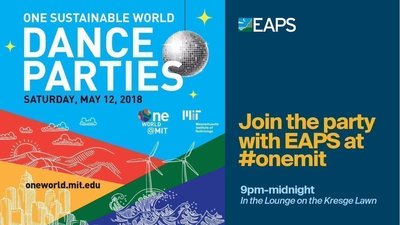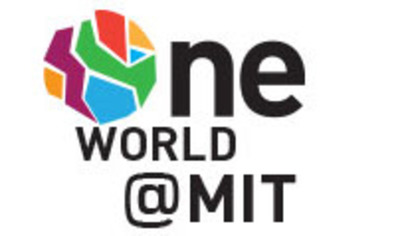PAOC Spotlights
One Sustainable World at MIT
Atmosphere, oceans and climate researchers help the MIT community visualize the future of sustainability.
Last Saturday, the entire MIT campus gathered for an evening of food, music, dance, fun, and exploration at One Sustainable World. They were celebrating sustainability through our shared experience of the oceans, energy, atmosphere, and Earth + community at One Sustainable World.
The event, which was orchestrated by the MIT Environmental Solutions Initiative, engaged and empowered members of the MIT community to commit to making lasting choices that will advance the well being and resilience of people and the environment. It also educated attendees about the ways in which MIT people, research, and current initiatives are creating a more sustainable future.
Researchers from the Program in Atmospheres, Oceans and Climate (PAOC) in MIT’s Department of Earth, Atmospheric and Planetary Sciences (EAPS) were there nourishing minds and showing how our environment unites us.

Glenn Flierl, Professor of Oceanography, presented the iGlobe showing atmosphere and ocean visualizations on a 2-foot sphere, complete with interactive GIS compatible with various datasets. Guests explored global circulations that connect and affect all of us, which helped them understand their patterns and how environmental actions on one part of the world could impact another.
Senior Lecturer and Meteorologist Lodovica Illari encouraged One Sustainable World attendees to think deeper about their air and water: where it comes from, where it’s going and what you’re exposed to in the environment. Using the EsGlobe (Environmental Science Globe)—an interactive display controlled by a touch screen—users computed air trajectories and, through the dynamic graphic, could understand the transport of heat, water vapor, aerosols, pollutants, biota, or other tracers both in the atmosphere and in the ocean.
Professor of Oceanography John Marshall revealed the truth about plastics in the ocean: how they move and how pervasive they are. To do this, he modeled ocean circulation around gyres with a rotating turntable, water in a tank, fans and paper dots, an exercise used in the lab. Marshall then put the problem into perspective with an illustration on the EsGlobe. Audiences launched virtual particles into the global ocean circulation and watched as they collected into “garbage patches” in gyres.
MIT undergraduate students Jennifer Fox, Arnav Patel and Vivian Zhong explored the future of sea level rise and flooding through visualization and augmented reality (AR). The activity was an outgrowth of the MIT Terrascope program’s focus this year on preparing coastal communities for the impacts of climate change. The program is led by EAPS Associate Professor of Paleoclimate and PAOC member David McGee.

 Related:
Related: